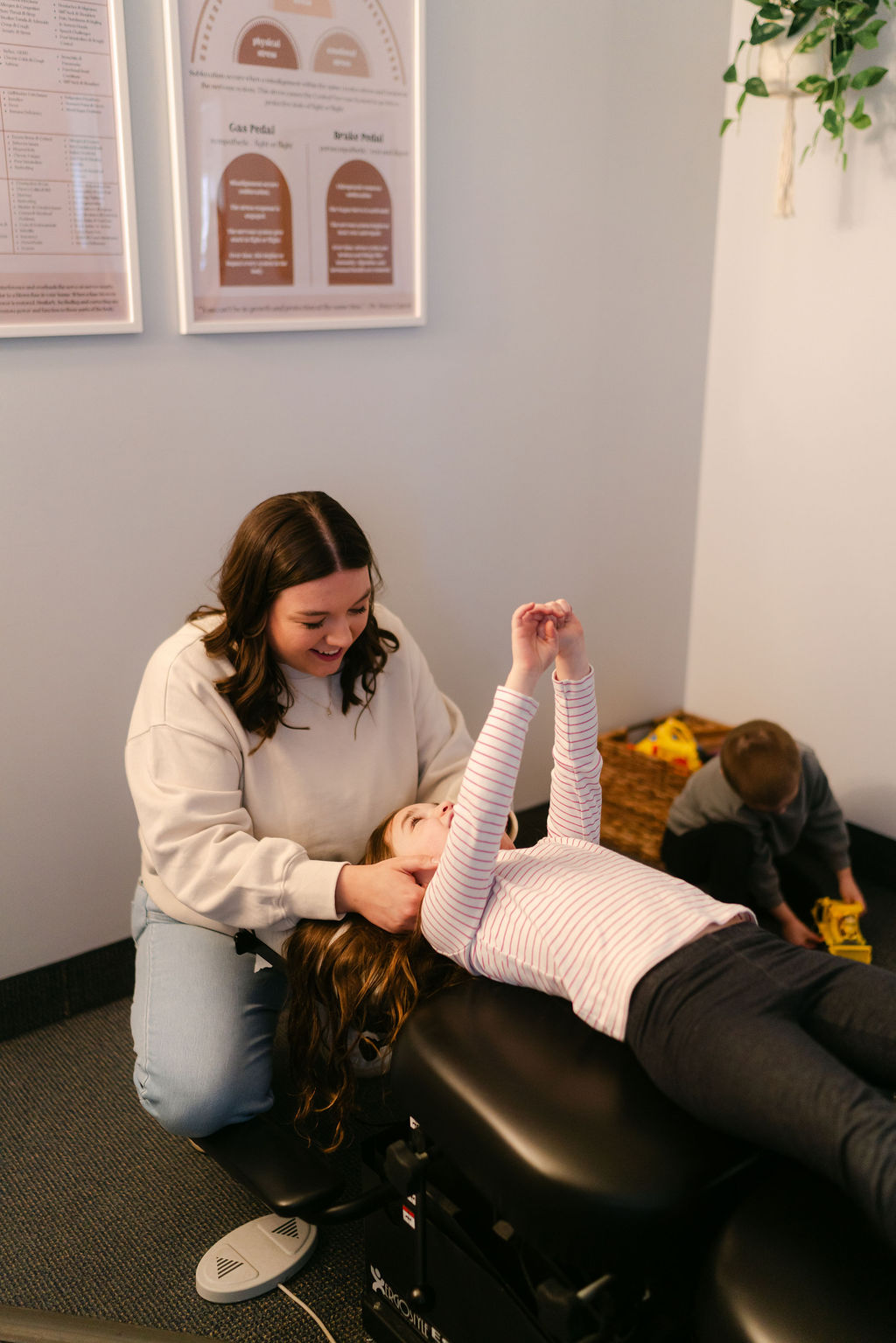WElcome TO
Explore our blog that focuses on holistic care for any and all ages - pediatric well-being, pre/post-natal health, and adult vitality.
THE BLOG

As a brand new parent, you want to give your newborn the absolute best start in life. You’re carefully selecting the safest car seat, researching the most nutritious feeding options, and creating the perfect sleep environment. But what many parents don’t realize is that even the most “normal” birth process puts tremendous physical stress on your baby’s delicate body. Particularly their brainstem, neck, and nervous system.
Birth Is More Physically Demanding Than We Realize
In the United States, nearly 1 in 3 deliveries now end in C-sections. Beyond that, many births involve other interventions like induction, forceps or vacuum delivery, and various forms of manual assistance. The numbers are quite staggering once you look closely at what’s happening in labor and delivery rooms across developed countries.
But it’s not just birth interventions that can cause concern. Even in natural, intervention-free births, the physical stress of labor and delivery places significant pressure on an infant’s spine and delicate nervous system. This pressure can lead to subtle birth trauma and neurological interference caused by misalignments, also known as subluxation, which may impact your child’s development, nervous system regulation, and overall health from the very beginning.
Understanding Those Challenging First Weeks
Those first few weeks with your newborn can be challenging if you are dealing with constant crying, difficulty nursing, sleep struggles, reflux, or colic. While conventional medicine often dismisses these as “normal baby problems” that they’ll eventually outgrow, these signs may actually be indicating underlying neurological dysfunction that can be addressed.
In a study from the American Osteopathic Association, subluxation or “somatic dysfunction” was found in 99% of healthy newborns. The severity and incidence of these biomechanical challenges within the spine and cranial system increase with longer labor times and the use of birth interventions.
This statistic may seem staggering, especially considering that conventional pediatricians typically have no training in identifying or addressing these issues. Even children born naturally without intervention can benefit massively from an early life chiropractic check-up that looks for subluxation and nervous system dysfunction.
Why Early Detection Matters
The reason it can be beneficial to find subluxation early is that it not only can cause immediate issues with latching, nursing, digestion, sleeping, and soothing—but they are NOT something your child will simply “grow out of.” Due to their location within the nervous system and brainstem regions, they commonly begin to affect various aspects of growth and development as time goes on—most notably interfering with gross motor development, fine motor skills, speech, and other developmental milestones.
The Science Behind Birth-Related Subluxation
Infants Cannot Protect Their Delicate Spine
What makes birth trauma particularly concerning is that newborns have no motor or muscular control developed yet, so they can’t protect themselves during the birth process. This significantly increases the likelihood and severity of neck and brainstem injuries from birth intervention.
Understanding Subluxation in Newborns
Subluxation in your baby’s neurospinal system has three key components:
- Misalignment within the neurospinal system, which can lead to issues like difficulty latching, torticollis (neck tightness), and plagiocephaly (flat spots on the head).
- Fixation and restricted motion. Movement is essential for a developing infant as it provides the brain with proprioception—when subluxation creates fixation, it reduces this vital input to the brain.
- Neurological interference and imbalance, which disrupts proper communication between the brain and body.
The Critical Role of the Brainstem and Upper Neck
All motor tone and development for the entire body is controlled and coordinated by the cerebellum, brainstem, and upper cervical region of the spinal cord. It functions like an “air traffic control” center. When the nerves and muscles of the upper neck and spine are compromised in the first moments of life, all motor development downstream is negatively affected.
And remember—motor development equals brain development in infants.
The Vagus Nerve Connection
The upper neck and brainstem region, the area most affected by birth trauma, houses the vagus nerve—the primary controller of your baby’s parasympathetic “rest, digest, and regulate” nervous system.
When birth trauma creates subluxation in this area, it can significantly disrupt vagus nerve function, leading to dysautonomia (imbalance in the autonomic nervous system). This disruption can affect virtually every major system in your baby’s body: digestive function (colic, reflux, constipation), sleep regulation, immune response, emotional regulation, and developmental milestones.
Common “Normal Baby Problems” That Signal Neurological Dysfunction
What if those common challenges aren’t just phases to endure but actual signs of a nervous system under stress?
- Colic and excessive crying aren’t just “phases” but often manifestations of a stressed nervous system struggling to regulate itself.
- Breastfeeding difficulties frequently stem from upper cervical subluxation affecting the cranial nerves that control sucking, swallowing, and other precise movements.
- Reflux and digestive issues often occur when vagus nerve dysfunction disrupts normal digestive motility.
- Sleep disturbances happen when a subluxated nervous system stuck in sympathetic dominance makes it difficult for babies to relax into deep, restorative sleep.
- Early developmental delays can occur when subluxation restricts normal movement patterns that stimulate proper neurological development.
The Gentle Approach of Pediatric Chiropractic Care
Unlike the adjustments you might picture for adults, newborn adjustments are incredibly gentle—using no more pressure than you would to test the ripeness of a tomato or press on your closed eyelid.
These precise, gentle techniques are specifically designed to release tension patterns and restore proper nervous system communication, allowing your baby’s body to function optimally.
We use advanced technology like INSiGHT Scans to identify precise areas of nervous system stress, allowing for highly specific and individualized care plans tailored to your baby’s unique needs.
Setting the Foundation for Lifelong Health
The first year of your baby’s life represents an extraordinary period of development. During this time, their brain will more than double in size and form more than a million new neural connections every second. These early patterns establish the foundation that will influence their health and development for years to come.
By ensuring that your baby’s nervous system is functioning optimally from the very beginning, you’re not just addressing immediate challenges like colic, reflux, or sleep issues—you’re setting them up for a lifetime of improved health, stronger immunity, better regulation, and optimal development.
Taking Proactive Action
Don’t wait until those “normal baby problems” become chronic issues. You can take a proactive approach to your child’s health by scheduling consultation at RCW with one of our neurologically-focused pediatric chiropractors as soon as possible after birth.
A comprehensive assessment will include a detailed health history, gentle physical examination, and advanced neurological scans to identify areas of nervous system stress.
We know that taking care of your newborn baby can be the most exciting AND nerve-racking time of your life! By considering neurologically-focused chiropractic care, you’re taking an important step toward giving your baby the best possible start—one where their nervous system can function optimally from day one, allowing them to grow, develop, and thrive as nature intended.

Keep reading to learn the key differences between standard chiropractic care, integrated or functional therapies, and truly specialized neurologically-focused Pediatric chiropractic care.
The Truth About Pediatric Chiropractic Care
Not all chiropractors are equipped to help children—especially those with complex neurological challenges like sensory processing issues, ADHD, or chronic health concerns.
Let us share a story about a young patient named Henry. He came to our practice after trying traditional chiropractic care without success. Henry struggled with intense sensory processing challenges—running full speed into walls for sensory input, having extreme reactions to clothing textures, and struggling with impulse control.
His previous chiropractor provided care, but without a neurological focus and proper frequency, Henry’s underlying issues weren’t being addressed. After just one month of specialized, neurologically-focused care, his mother noticed profound changes they hadn’t seen before. His sensory-seeking behaviors became less intense and more manageable, and his overall regulation improved dramatically.
So what makes the difference? There are core components that determine whether your child is getting the right care. They may seem simple, but they make all the difference.
The 5 Critical Elements That Make Pediatric Chiropractic Care Effective
1. Advanced Education and Training
Most chiropractors have advanced training in spinal care, back pain, neck pain, etc. But taking care of kids requires specialized pediatric training that goes far beyond basic chiropractic education.
Today’s children face what we call “The Perfect Storm“—unfortunately high levels of stress and toxicity building up early in their lives, contributing to the fact that over 50% of kids today are chronically ill or struggling with complex health conditions.
Advanced pediatric training includes a deep understanding of:
- Developmental milestones
- Nervous system function
- Brain development
- The gut-brain connection
- Neuroinflammation
- And much more
When your child’s care provider has this specialized training, they’re better equipped to address the root causes of your child’s challenges rather than just treating symptoms.
2. Experience with Pediatric Cases
While many chiropractic practices may have “Family” in their name and see a few kids here and there, you’re really looking for someone who is FULLY focused on Pediatric and Family Care and has extensive experience with complex cases.
An experienced pediatric chiropractor should have a track record of successfully working with children who have:
- Sensory processing challenges
- ADHD
- Autism
- Chronic conditions like ear infections or constipation
- And even more complex conditions like seizures or special needs
You’re also looking for an office that is fully focused on kids in terms of the environment, layout, and approach—a place where your child feels comfortable and welcomed.
3. Advanced Technology and Neurological Testing
In 2025, it’s essential that your child’s chiropractor uses advanced technology like INSiGHT Scans to properly assess nervous system function.
These non-invasive scans take just 15-20 minutes yet provide more information on the real root cause of your child’s condition than many other forms of testing. They allow practitioners to find nervous system dysfunction, dysregulation, and subluxation with precision.
Most importantly, these scans should be performed throughout care to track progress and ensure that real neurological change, healing, and restoration is happening.
4. Multiple Adjusting Techniques
Each child’s case is unique and requires a personalized approach. Using one singular technique often limits results in complex cases.
Different adjusting techniques address various aspects of nervous system dysfunction. A one-size-fits-all approach simply won’t address complex pediatric needs.
The right pediatric chiropractor should be well-versed in multiple techniques and able to adapt their approach to your child’s specific needs and comfort level.
5. Appropriate Care Planning
Today’s children often need more intensive care plans than previous generations due to the increased neurological challenges they face.
A proper pediatric care plan should include:
- Frequency and duration based on neurological assessment, not just a standard “one-size-fits-all” approach
- Adaptability as your child progresses
- Regular reassessment to ensure optimal results
- Clear communication with parents about expectations and progress
Finding the Right Care for Your Child
If you’re feeling frustrated with your child’s current chiropractic care, or if you’re just starting to explore options for your child’s health, now is the time to make a change.
The right care can make all the difference—just ask Henry’s mom, who saw transformation in her son after finding the right provider.
Your child deserves care that’s specifically designed for their unique needs. With the right chiropractic care, you can give them the support they need to reach their full potential.
Remember, it’s not that chiropractic doesn’t work for children—it’s that not all chiropractors are equally prepared to work with children, especially those with complex neurological challenges.
Taking the Next Step
If you’re ready to explore this type of neurologically-focused pediatric chiropractic care for your child, reach out to RCW today! We specialize in this specialized form of neurologically-focused care and are here to make both you and your child feel comfortable, heard, and hopeful. If you are not local to us, check out the PX Docs directory to find a PX Docs office near you.
Your child’s health journey deserves the best possible support. With the right care, we can help your child thrive—neurologically, physically, and emotionally.

“It’s just allergies.” How many times have you heard these words that seem to minimize what your child goes through every day? If you’re a parent watching your child battle constant coughing, sneezing, runny nose, and itchy eyes – along with the crushing fatigue and irritability that comes with both the allergies and their medications – you know it’s never “just” anything.
The Reality of Seasonal Allergies in Children
Nearly one in five children suffer from seasonal allergies. Though if you look around during peak allergy seasons, that number seems conservative. These aren’t just minor inconveniences – they’re life-altering conditions that can keep kids from fully enjoying their childhood. No child should have to live in fear of pollen counts, nature hikes, or playing at a friend’s house because of their allergies.
Let’s share a story about Stella, a young patient whose journey might sound familiar. She came to our office struggling not just with seasonal allergies, but also with sensory issues and focus problems. Her parents had tried numerous therapies, but something was still missing. After addressing the underlying neurological component of her allergies, everything changed. As her mother shared, “No more green boogers during allergy season is a huge plus”! But what’s even more remarkable is how neurologically-focused chiropractic care improved multiple aspects of Stella’s health. From better focus to improved body awareness and even trying new foods.
Moving Beyond Traditional Approaches
If you’ve been told that allergies are purely genetic and there’s nothing you can do about them, or if you’ve been focusing solely on special diets and gut healing, there’s something crucial you need to know: while these approaches have merit, there is a good chance they are missing a fundamental piece of the puzzle.
The Hidden Connection: Your Child’s Nervous System
What many healthcare providers – both conventional and natural – often miss is the crucial connection between your child’s nervous system and their allergic responses. When the nervous system is dysregulated and stuck in “sympathetic overdrive,” it keeps the immune system hypersensitive and in a constant pro-inflammatory state. This explains why some children develop severe allergic responses while others remain completely unbothered by the same environmental triggers.
Understanding the Root Cause
The conventional medical approach often views seasonal allergies as simply an overreaction to pollen and other allergens. However, the truth goes much deeper – it’s about how your child’s nervous system regulates their immune response. This understanding opens up new possibilities for healing.
The Impact of Early Medical Interventions
One factor that’s often overlooked is how early medical interventions can contribute to allergy development. The overuse of antibiotics in infants, especially within the first two years of life, has been linked to increased risk of allergies and autoimmune conditions. Here’s why:
- Disruption of the Gut Microbiome: About 70-80% of your child’s immune cells reside in the gut. Antibiotics don’t discriminate between helpful and harmful bacteria, potentially disrupting this delicate ecosystem.
- Impact on Immune Development: Early antibiotic exposure can alter the balance between different types of immune responses (Th1/Th2), potentially predisposing children to allergic reactions.
Research supports these concerns:
- A 2020 study in JAMA Pediatrics found that children exposed to antibiotics in their first year had an increased risk of asthma, allergic rhinitis, and eczema
- The Lancet Respiratory Medicine reported that early-life antibiotic exposure significantly increases the risk of childhood asthma
The Inside-Out Approach to Healing
The key to understanding your child’s allergies lies in recognizing that the real issue isn’t the external environment – it’s how their body responds to it. When the nervous system is dysregulated, it can lead to:
- Increased tension affecting drainage of the ears, nose, throat, and lymph nodes
- A hypersensitive immune response
- Constant pro-inflammatory states
Taking Action: A Natural, Drug-Free Approach
The good news is that you have options beyond just managing symptoms. By addressing the underlying nervous system dysregulation with neurologically-focused chiropractic care, many families are finding lasting relief for their children.
Steps You Can Take:
- Address Nervous System Function: Consider having your child evaluated for nervous system dysregulation, which could be the major missing piece in their healing journey.
- Support Gut Health: While not the complete answer, maintaining a healthy gut microbiome through proper nutrition and probiotic support is important.
- Reduce Inflammatory Triggers: Work with a healthcare provider who understands the connection between nervous system function and immune response.
- Look Beyond Symptom Management: Instead of simply treating symptoms, focus on addressing the root cause of your child’s allergies.
At RCW we use advanced scanning technology called INSiGHT Scans that help us access your child’s nervous system, and locate any subluxation and dysregulation. From there we put together a personalized care plan and use gentle adjustments that will help regulate their nervous system function.
A New Path Forward
Don’t let another allergy season keep your child from experiencing life to the fullest!
Understanding the role of nervous system regulation in allergic responses opens up new possibilities for natural, lasting relief. Whether spring is just around the corner or you’re already in the midst of allergy season, know that there’s hope beyond just managing symptoms. Your child deserves to experience life without the burden of seasonal allergies, and with the right approach, that is absolutely possible.






